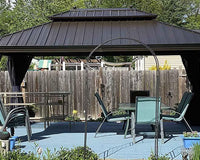Introduction
Looking for a spot to enjoy your backyard without wilting in the sun? An outdoor umbrella may be your best friend on those really bright, sunny days. Of course, you need the right stand so it won't tip over with each breeze that breezes by. In this article, we're going to talk about why an outdoor umbrella stand isn't a nice-to-have but a must-have for people who want to relax in their outdoor space without any concerns. From garden get-togethers to lazy afternoons by the pool, we will let you know how picking up and using the right outdoor umbrella with a stand makes all the difference.
What is an Outdoor Umbrella Stand, and Why Do You Need One?
An outdoor umbrella stand may not steal the spotlight when you’re setting up your patio, but it sure is a good tool that holds everything together. Think of it as the trusty sidekick to your outdoor umbrella – it’s there to make sure your shade stays put, no matter if the wind decides to dance.
The Role of a Stand in Your Outdoor Setup
A stand is more than just a heavy object; it's the anchor that prevents your umbrella from becoming a runaway kite. Without it, your outdoor umbrella could topple over, which potentially causing damage or injury. Plus, no one enjoys chasing after their umbrella when they’re supposed to be relaxing.
Stand Types
Outdoor umbrella stands come in a wide variety of shapes and sizes. They can be simple - like a weighted base you fill with sand or water - or quite elaborate, with designs that complement your outdoor décor. Some are built for portability, perfect for beach days, while others are meant to be permanent fixtures in your garden or on your deck.
Pairing Your Umbrella With the Ideal Stand
Choosing an outdoor umbrella with a stand isn’t a one-size-fits-all affair. You'll want to consider the size of your umbrella, the conditions in your outdoor space, and even the material of the stand itself. A small, light umbrella on a compact balcony might need a different kind of support compared to a large, sprawling setup designed for backyard barbecues.
How Do Outdoor Umbrella Stands Work?
To appreciate the importance of a good outdoor umbrella stand, it's helpful to know a little about the science that keeps your umbrella upright and functional.
Physics
It's all about balance and resistance. An outdoor umbrella stand works by providing enough weight and grip to counteract the forces acting on the umbrella. Whether it’s the pull of gravity or the push of the wind, a well-designed stand has to keep everything steady. The wider the base and the heavier the stand, usually, the more stable your umbrella will be.
Weight, Durability, and Design
Outdoor umbrella stands are made from a variety of materials. Common choices include metal, concrete, and plastic – each with its own set of benefits. Metal stands are often sturdy and can add a touch of elegance, while concrete is all about heft and staying put. Plastic stands, which are frequently fillable, offer versatility since you can adjust their weight as needed.
When Stands Stand Up (or Don’t)
We've all seen those moments when a strong gust sends umbrellas tumbling across the beach or patio. The difference between an umbrella that stays put and one that doesn't often comes down to the stand's design and its suitability for the situation. A stand with a low center of gravity and a secure fitting for the umbrella pole will resist tipping and twirling much better than one without these features.
In essence, a good outdoor umbrella stand acts as the foundation for your slice of shade. It ensures that your umbrella is not only a source of comfort but also a safe addition to your outdoor space.
Choosing the Perfect Outdoor Umbrella Stand for Your Space
Once you understand the physics of stability, the next step is selecting the ideal outdoor umbrella stand that fits your needs.
Get the Proportions Right
An outdoor umbrella stand must suit the size of your umbrella. A large patio umbrella requires a heavier and broader base to maintain balance than a smaller one. It's crucial to check the diameter of your umbrella pole, too, ensuring that it fits snugly into the stand without wobbling.
How Much Heft Do You Need?
The general rule is: the larger the canopy, the heavier the base needs to be. For example, an umbrella with a 6-foot canopy might require a stand that weighs at least 20 pounds, while a 9-foot canopy could need a base that's upwards of 50 pounds. Always err on the side of more weight for windy areas or high-traffic spaces where the umbrella might get bumped.
Material Choices
Selecting a material for your outdoor umbrella stand is a balance between aesthetics and functionality. Metal stands can range from wrought iron to stainless steel, each offering different levels of durability and style. Concrete stands boast exceptional stability and often come in decorative designs. Plastic or resin bases are lightweight when empty, perfect for storage or travel, but can be filled with sand or water to ramp up their weight.
Environmental Fit
Consider the typical weather conditions and the type of surface where the umbrella will be placed. Windy locations may require heavier or more securely anchored stands. If you're placing your umbrella on a deck or balcony, ensure that the stand won’t scratch or damage the flooring.
Stand Features
Some outdoor umbrella stands come with additional features like adjustable screws to secure the umbrella pole or wheels for easy movement. Look for stands with rust-proof materials if they’ll be exposed to the elements regularly or ones with built-in handles if you plan to move them frequently.
Install Your Outdoor Umbrella Stand: A Step-By-Step Guide
Correct installation not only ensures your umbrella stays upright but also extends the life of both the umbrella and the stand.
- Prepare for Installation: Before you begin, make sure you have all the necessary tools and materials on hand. Depending on your stand, this could include a screwdriver, sand or water (for fillable bases), and possibly a friend to help with heavier stands. It's also a good idea to read through any instructions that come with your stand.
- Positioning Your Stand: Think about where you want your umbrella to go. Look for a level area away from high traffic to minimize the risk of tipping. If possible, place your stand in a spot that offers some natural shelter from the wind, like near a wall or a hedge.
- Securing the Umbrella Pole: Once the stand is positioned, slide the umbrella pole into the stand's sleeve. Make sure it’s centered. If the stand in question has a tightening mechanism, such as screws or bolts, tighten them securely to hold the pole in place. Avoid over-tightening, which can damage the pole or the stand itself.
- Adding Weight: For fillable stands, now's the time to add weight. Use clean sand for denser, more stable weight, or water if you need something easier to remove later. Some stands have separate chambers for adding weight – be sure to distribute it evenly to maintain balance.
- Final Checks: Give your umbrella and stand a gentle shake to check stability. Observe if there's any movement at the base of the connecting points. If you notice wobbling, double-check that all parts are secured tightly and that the weight is sufficient.
- Longevity Tips: To ensure your umbrella and stand last as long as possible, consider adding protective pads under the base to prevent scratches on surfaces like wood decking. Also, regularly check and tighten any bolts or adjustment mechanisms that may loosen over time due to wind or regular use.
The Indispensable Outdoor Umbrella Stand
Outdoor leisure is where supporting the umbrella itself becomes important: the stand that ensures your shade will never leave your side and that your relaxation will not be hampered by any whims of nature. It may not be on par with the umbrella itself, but it takes a very crucial role in shaping a haven for comfort and safety. From securing towering canopies to theme aesthetics, it's the right stand that acts as the resolute protector of your serene moments spent under the open sky. It means that selecting the perfect outdoor umbrella stand is more than just practical—it's one of the integral parts of curating your ultimate retreat from the world's bustle. Using your insight, the outdoors will then be well-equipped for calmly appointed days.




